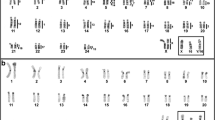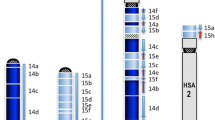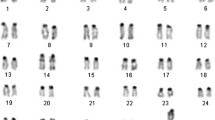Abstract.
We used reciprocal chromosome painting with both African green monkey (C. aethiops) and human chromosome specific DNA probes to delineate homologous regions in the two species. Probes were derived by fluorescence-activated chromosome flow sorting and then were reciprocally hybridized to metaphase spreads of each species. Segments in the size range of a single chromosome band were identified, demonstrating the sensitivity of the approach when comparing species that diverged more than 20 million years ago. Outgroup analysis shows that the great difference in diploid numbers between the African green monkey (2n = 60) and humans (2n = 46) is mainly owing to fissions, and the direction of change is towards increasing diploid numbers. However, most break points apparently lie outside of the centromere regions, suggesting that the changes were not solely Robertsonian as has been previously assumed. No reciprocal translocations have occurred in the phylogenetic lines leading to humans or African green monkeys. The primate paints established here are a valuable tool to establish interspecies homology, to define rearrangements, and to determine the mechanisms of chromosomal evolution in primate species.
Similar content being viewed by others
Author information
Authors and Affiliations
Additional information
Received: 10 December 1998 / Accepted: 18 February 1999
Rights and permissions
About this article
Cite this article
Finelli, P., Stanyon, R., Plesker, R. et al. Reciprocal chromosome painting shows that the great difference in diploid number between human and African green monkey is mostly due to non-Robertsonian fissions. 10, 713–718 (1999). https://doi.org/10.1007/s003359901077
Issue Date:
DOI: https://doi.org/10.1007/s003359901077




